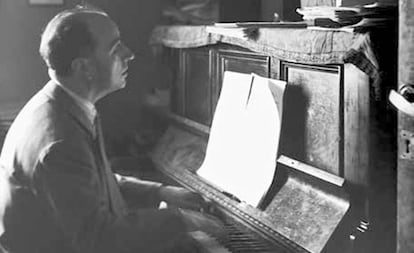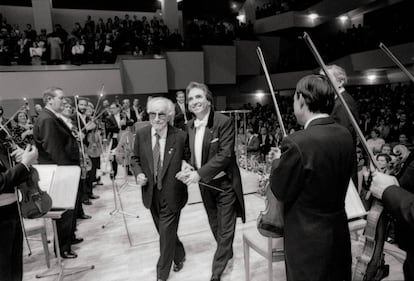“Man, that’s done!” This confident expression triggered one of the most famous compositions in the history of music: the Aranjuez’s concertby Joaquín Rodrigo (Sagunto, 1901 – Madrid, 1999). On September 26, 1938, the Spanish composer was having lunch at the San Sebastián Yacht Club with the guitarist Regino Sáinz de la Maza, who urged him to compose a concerto for his instrument, telling him that he was a kind of “chosen one.”
The idea seemed crazy. Few composers had dared to confront the intimate volume of a Spanish classical guitar with the sonorous density of a symphony orchestra. And, in fact, in November 1940, when the work was already finished and both were travelling to Barcelona for its premiere, Rodrigo was not entirely confident: “What if tomorrow, during the rehearsal, the guitar was not heard?”
These and other details of the popular Aranjuez’s concertwhose beautiful adagio It has been covered by Miles Davis and Chick Corea and has been featured in several films and television commercials, including A Light in the Darkness: The Music and Life of Joaquín Rodrigoby Javier Suárez Pajares and Walter Aaron Clark. The first biography of a Spanish composer published by the prestigious American publishing house WW Norton & Company. And also the most complete study of his life and musical work, which begins at the beginning of the 20th century with the ocular diphtheria that left him blind at the age of three, and culminates with his death, almost a centenary, on July 6, 1999, exactly twenty-five years ago today.
A portrait of the composer, performer, writer, professor, cultural diplomat and media celebrity who does not avoid a context marked by the ups and downs of the 20th century. The youngest son of a conservative chieftain from Sagunto who grew up in the republican and anticlerical Valencia of Blasco Ibáñez. But also a blind child oriented towards musical creation, in the pioneering School for the Deaf and Blind in the capital of Turia, through a modified and expanded version of the Braille system.
A young musician who liked to provoke the public with polytonal turns, but with the financial means to move to Paris in 1927 to study with Paul Dukas. There his name was soon connected with Albéniz and Falla, and he even found his life partner: the Sephardic pianist Victoria Kamhi (1902-1997). Years later, the composer faced financial difficulties during the Spanish Civil War, which took place between Hitler’s Germany and pre-occupied Paris. He defined the characteristics of his “neo-classicalism”, a musical style rooted in the modernized national tradition. And he secured the support of the Falangist cultural environment that allowed him to settle in Franco’s Spain, where he worked at Radio Nacional, the newspaper Pueblothe Madrid Conservatory and the current Complutense University.
The central chapter of the book is titled All About The ‘Concierto de Aranjuez’ (1938-1940). More than fifty pages with all the details about the composition that allowed Rodrigo to cross the select threshold of music history and gain immense popularity. A work written from the end of 1938 to mid-1939 and whose creation began with the famous melody played by the English horn at the beginning of the adagio.

His wife’s memoirs have always linked the inspiration for that melody with the tragic miscarriage she suffered in June 1939. But the dates do not match. Today we know that Rodrigo wrote that piece in November 1938, shortly after hearing the song in concert. Passion according to Saint Matthewby Bach, and get excited with the aria Have mercy which is, precisely, in the same key of B minor. It seems a plausible origin for a melody that unfolds halfway between the neoclassicism of Stravinsky and the new lyricism from his teacher Dukas.
To the composition of the adagio followed, almost like a burst, that of the third movement, cheerful kindwhich was completed in March 1939. He then took on the writing of the first, cheerful with spiritwith a much more rhythmic than melodic approach and closer to flamenco. But the inspiration for the work does not seem to be related to the gardens and palace of Aranjuez, which Rodrigo had visited in 1933, but rather to the gardens and palace of Luxembourg, located very close to the humble apartment he occupied on the Parisian Rue Saint-Jacques.
However, the title of this composition has determined his perennial link with the Madrid municipality on the banks of the Tagus. Not only did he receive the noble title of Marquis of the Gardens of Aranjuez from the King of Spain in 1991, but his mortal remains rest in its Municipal Cemetery. A tomb adorned by the modernist sculpture by Pablo Serrano that represents the famous melody of the adagio next to a guitar.
Love for the guitar
Rodrigo’s close identification with that instrument was before and after the Aranjuez’s concert. Its catalogue almost starts with Distant sarabande (1926) and continues with the imposing Touched (1933). Almost all the guitarists with whom he collaborated were great interpreters of the Aranjuez’s concert. Sáinz de la Maza himself made his first recording, in 1948, under the direction of Ataúlfo Argenta (Odeon). But the exception was Andrés Segovia, who never played that popular concerto, although he would premiere his Fantasy for a gentleman (1954). Next came Narciso Yepes, whose recording with the RTVE Orchestra in 1968 remains a reference (DG).
Rodrigo wrote for Julian Bream the Playful Sonata (1959). And the colourful and articulate version of the Concierto de Aranjuez recorded in 1982 by this British guitarist with John Elliot Gardiner (RCA), offers an ideal balance between soloist and orchestra. But the best recording emerged from the charm and fluidity of Pepe Romero under the direction of Neville Marriner, in 1978 (Philips). The Malaga guitarist also premiered the Madrigal concert (1966) with his brother Ángel, the Andalusian concert (1967) with the family quartet of guitarists, and was also responsible for the Concert for a party (1982), Rodrigo’s second concertante work for solo guitar. But we must not forget the exquisite flamenco freedom of Paco de Lucía in his 1991 recording with the Cadaqués Orchestra (Philips).

The book by Suárez Pajares and Clark allows us to delve chronologically into each and every one of Rodrigo’s compositions through precise explanations, tables and musical examples. Among his piano compositions, the following stands out: Prelude to the morning rooster (1926) full of harsh dissonances and disordered rhythms, the lyrical and intense Farewell sound (1935) as a farewell to his teacher Dukas and the scent of Satie from his Great march of the undersecretaries (1941). Of the orchestral works, the symphonic poems stand out, both the lyrical one For the blue lily flower (1934) as the surprising In search of the beyond (1976) inspired by a visit to NASA. And we must not forget his vocal works, both Serrani (1928) popularized by Conchita Supervía, the colorful extension of Falla that we hear in Absences of Dulcinea (1948) and inventiveness Music for a Salamanca codex (1953) on verses by Miguel de Unamuno.
But if there is one constant in his catalogue, it is concertos for different instruments as a result of his collaborations with great soloists. A collection that began, precisely, with the Aranjuez’s concert. Continue with the Heroic concert (1942) for piano and the Summer Concert (1943) for violin. There is also the Concert in gallant mode (1949) for cello that arose from his relationship with Gaspar Cassadó and the Serenade Concert (1954) for harp for Nicanor Zabaleta. And, leaving aside the works already mentioned for one or more guitars with orchestra, the Pastoral Concert for flute inspired by James Gallway (1978) along with the Concert as a diversion (1981) for cello. This work was commissioned by Julian Lloyd Webber, who underlines in the book’s prologue the lack of knowledge of Rodrigo’s work beyond his Aranjuez’s concert: “A hidden treasure waiting to be discovered.”
Subscribe to continue reading
Read without limits
_

